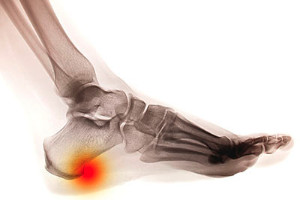
Heel spurs are calcium growths that can develop on the bottom of the calcaneus, or heel bone, usually as the result of tension and inflammation of the plantar fascia. Heel spurs are benign, and many times are not painful if they form gradually. Heel spurs that develop suddenly can be quite uncomfortable, especially right after getting up in the morning. Women are more apt to have heel spurs than men, possibly because of the type of shoes that are worn. Making changes in footwear is the first way to ease any pain from heel spurs. To address this problem, look for shoes that provide additional cushioning in the heel, or have custom orthotic inserts made to specifically fit your feet. Finding footwear with ample arch support is another method of easing the pressure on the heel bone, along with performing stretching exercises to reduce tightness in the calf muscles. Obesity and bone deformities on the foot may be other contributing factors in the development of bone spurs. To address these and other issues related to heel spurs, it is suggested that you make an appointment with a chiropodist.
Heel spurs are bony outgrowths from calcium deposits. They occur at the back of the heel bone or underneath the heel bone and usually form in response to chronic irritation of the Achilles tendon or plantar fascia. They are often asymptomatic, but if you are suffering from heel pain, please consult with one of the chiropodists from Complete Family Footcare & Therapy. Our clinicians can help you maintain the health of your lower limbs and your mobility.
Symptoms of Heel Spurs
-
Tenderness
-
Heel pain
-
Pain when walking
-
No symptoms
Diagnosis
Since heel spurs are often asymptomatic, they are usually only diagnosed when they are found on the heels incidentally during an X-ray taken for another reason. Nevertheless, if you have heel pain, and particularly if you have plantar fasciitis or Achilles tendonitis, it may be worth it to see if you have heel spurs too.
Treatment
Unless they are causing symptoms, heel spurs typically don’t require any treatment. When they are symptomatic, treatments are typically conservative. They may include resting and icing the affected foot, taking anti-inflammatory medications, and wearing orthotics or supportive footwear, especially while exercising.
If you have any questions, please feel free to contact our offices located in . We offer the newest diagnostic and treatment technologies for all your foot care needs.
